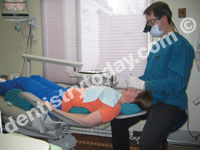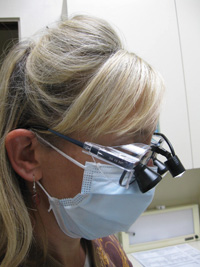Concepts of dental operator seating have changed greatly since seated, 4-handed dentistry was first embraced by the profession in the 1960s. Early designs of dental stools were simple (often flat, round seat pans) with minimal adjustability and a one-size-fits-all mentality. Although this move from standing to sitting dentistry promised to reduce the high incidence of work-related pain among dentists, statistics indicate that this goal has not yet been realized.1-5
In an effort to improve working comfort and reduce musculoskeletal disorders among dental operators, manufacturers have promoted multiple design concepts to the marketplace. Although it must be understood that the prevention of work-related pain and musculoskeletal disorders (MSDs) is a multifactorial issue,6 the choice of proper seating is critical and can either improve or worsen a clinician’s comfort and level of musculoskeletal health. It is the opinion of the authors that no ideal chair design exists for dental operators. We have also observed multiple instances of operators (dentists, hygienists, and assistants) using otherwise well-designed ergonomic chairs and stools improperly. This is often due to lack of knowledge as to how to adjust ergonomically designed chairs correctly, combined with a lack of understanding as to how these adjustments impact the biomechanics of the operators and their musculoskeletal health.
An important aspect of choosing and optimally adjusting chairs or stools for any individual operator is to understand the effects that a person’s height has on that choice. While it is obvious that people purchase shoes or clothing that fit properly, it seems to be far less so for dental professionals when choosing the chairs that they spend a significant portion of their careers upon. Although many manufacturers provide options to accommodate different operators’ heights and body sizes, many are sold with standard features that have been designed based on a statistically average-sized person (usually a man). These features may fit and support some operators well, but can cause multiple problems for others.
CHAIRS VERSUS STOOLS
Some confusion exists in the dental profession as to what differentiates a dental stool from a chair. Technically, a stool does not have a back or armrests, so the majority of seating available to dentists today are chairs. Perhaps in an effort to avoid confusion, dental manufacturers frequently refer to patient seating as chairs and doctor seating as stools. For the purposes of this article, we will distinguish between the two, considering both chair and stool designs for the dental operator.
SEAT TILT AND LOW-BACK PAIN
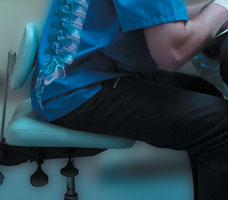 |
| Figure 1. Sitting with thighs parallel to the floor promotes flattening of the lumbar spine. |
Most dentists and hygienists were taught in school to sit with thighs parallel to the floor, or hips at a 90º angle. This paradigm for seated work has been widely accepted for generations and may be due in part to the design of early operator chairs, which featured flat, nonadjustable seat designs. The nature of dentistry makes intermittent forward leaning virtually unavoidable. This combination of thighs parallel to the floor with forward leaning causes the pelvis to roll backward, promoting flattening of the low back curve7,8 (Figure 1). Research shows that this flattening of the lumbar curve has detrimental effects upon both the spinal musculature and discs. Muscular activity in the lower back increases, which can cause ischemia and painful trigger points. Pressure within the disc also increases, which can lead to premature disc degeneration. The research therefore supports the concept of positioning hips higher than knees, allowing for an increased hip angle with lower associated low-back muscle activity and disc pressure.7,10
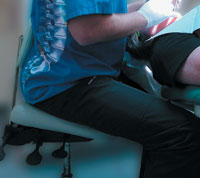 |
| Figure 2. A tilting seat helps maintain the low back curve, reducing muscle and disc pressures. |
Chairs with a tilting-seat feature as well as saddle-style stools enable the hip angle to open to greater than 100º, which helps maintain the low back curve, decreases disc pressure, enables closer positioning to the patient, and may help reduce low back pain7,10 (Figure 2). It is essential for operators to maintain—as best as possible—the normal curvature of the spine while working.
TALL AND SHORT OPERATORS
In general, tall operators with long trunks tend to have a higher incidence of low-back pain. This is partly due to gravitational forces acting on a longer lever arm when the operator assumes any degree of forward leaning. On the other hand, many dentists with shorter torsos tend to have neck and shoulder pain due to arm elevation when the patient is placed at lap level.
In the past, operator chairs were often designed for the average man. This trend is changing in response to the evolving demographics of the dental profession in which approximately 70% of operators (dentists and hygienists combined) are now women.11 It is common, however, for stools and chairs to be sold “as is,” offering standard features and little regard to the special needs of individual operators. Fitting a standard seat with a short or tall cylinder may allow operators to maximize the ergonomic benefits of the chair. Therefore, special considerations are need-ed for tall and short operators.
Considerations for Taller Operators (Generally 5’10” and Over)
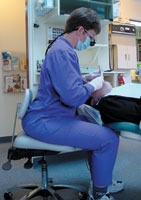 |
| Figure 3. Pivoting forward properly from the hips allows the operator to maintain the 3 primary spinal curves. |
Tall dentists with long torsos are most prone to flattening the low back and should pay particular attention to strength-ening of the transverse abdominal muscles. These muscles can be used throughout the day to regularly stabilize the low back curve,12,13 especially with forward leaning. The following “operator pivot” exercise recruits these muscles to stabilize the spine (Figure 3). While this exercise is especially helpful for tall dentists with long torsos, all operators can benefit by incorporating it into their daily routine:
•Sit tall on the stool with a slight curve in the low back.
•Assume an operating position with the arms.
•Exhale, and actively (with your muscles) pull your navel toward your spine. Your transverse abdominal muscles are now helping maintain your low back curve. (One common mistake is to suck in one’s breath to pull the spine toward the navel. You should still be able to talk, breathe, and move while holding this contraction.)
•Using the hips as a fulcrum, pivot forward from the hips, maintaining the abdominal contraction throughout the exercise.
•Strive to make this exercise a habit throughout the workday anytime you must leave a balanced sitting posture.
•A tilted seat pan or saddle-stool design will facilitate pivoting from the hips, making this exercise easier.
| Table. Chair Height and Adjustment (Figure 4).
To determine if you need a tall or short cylinder, you must first adjust the chair: (1) Sit all the way back on the seat. (2) Adjust the height of the backrest to nestle in your low back curve. (3) Move the backrest away from your back. (4) Tilt the seat slightly forward. (5) Adjust the height with feet flat on the floor so your thighs slope slightly downward. (6) Sit upright with a slight curve in your low back. (7) Bring the backrest forward to contact the curve of your low back snugly. |
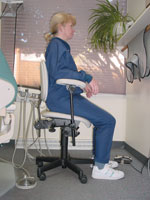 |
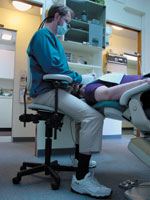 |
| Figure 4. Proper adjustment of an ergonomic chair. (Chair courtesy of Orascoptic Research.) | Figure 5. A tall cylinder helps taller operators position themselves correctly. |
Assess the height of the chair (Table) to evaluate whether a tall cylinder is required (Figure 4). If, at the highest height adjustment, your thighs are still parallel to the floor or your lower legs must be tucked underneath the chair, consider requesting a taller cylinder from the manufacturer (Figure 5). Often, this is simply the cylinder from the same model assisting stool.
Longer-legged operators should also assess seat pan depths of various chair and stool designs, as operator seat pan depths may range from 14 to 17 inches deep. The thighs should be well supported with feet flat on the floor. Taller operators should always raise the patient chair to a height that promotes their own best posture while conversing with the patient or consulting chair-side. This will allow for a more neutral posture during these times. A few minutes here and there add up over the course of a 20- to 30-year career in dentistry and can exacerbate existing musculoskeletal problems.
Magnifying scopes are an important ergonomic consideration for all dentists, but especially so for taller operators. It is nearly impossible for a tall dentist with a long torso to delivery quality dentistry with the patient at lap level and still sit upright. Make sure the working distance is measured in your own operatory (eye to working surface) with arms relaxed at your sides.
Considerations for Shorter Operators (Generally 5’ 4” and Under)
It is common to see shorter dentists with legs positioned under the patient, perched on the edge of the chair, arms abducted away from the body, and neck twisted to gain better visibility. This is commonly due to a positioning challenge related to the operator’s smaller stature. Even with the patient positioned correctly at lap level, simply the thickness of the headrest combined with the height of a patient’s head may cause some operators to elevate the arms—a contributing factor to neck pain. The challenge is to position the patient low enough to operate with arms in a relaxed, neutral posture. Opening the hip angle, utilizing a shallower seat pan, and use of a shorter cylinder are considerations for these dentists.
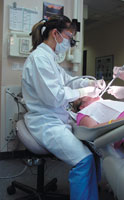 |
| Figure 6. A saddle-style stool opens the hip angle, allowing lower positioning of the patient. (Bambach saddle stool courtesy of Hager Worldwide.) |
The greatest hip angle may be obtained with the use of a saddle-style stool (Figure 6). This places the pelvis in a position that facilitates maintenance of the low back curve. By opening the hip angle up to approximately 140º, the stool allows for lower positioning of the patient and also closer positioning of the operator to the patient. The seat pan of a chair should be shallow (14 to 15 inches) and not touch the backs of the knees when seated all the way back in the chair. Assess the height of the chair (Table) to see if a shorter cylinder is required. You may need to request a shorter cylinder if, at the lowest adjustment, the following situation occurs:
•You cannot sit all the way back on the seat without easily fitting 2 to 3 fingers between the edge of the seat and the back of your knee.
•You do not feel weight evenly distributed through both legs and your buttocks.
•You feel you have to perch on the edge of the chair.
Other Considerations
Armrests are helpful in reducing neck and low-back strain for operators of all heights.14,15 Operators may consider the options of working with different styles of chairs and stools in different operatories as well as intermittently standing to spread the workload between different groups of muscles throughout the day.
CONCLUSION
Dental operators must become more educated regarding the impact of their choices in seat-ing in the operatory. Over a 30-year career, dentists and hygienists may spend upwards of 60,000 hours chairside or more than 1,800 days. Proper selection of chair/stool styles depends on many factors, and operators should try a stool or chair before purchasing it to assess how it fits their specific needs. However, even a well-designed chair or stool can detrimentally impact one’s musculoskeletal health if it is improperly equipped or adjusted for an individual’s body stature. The preceding guidelines should aid operators in their selection and adjustment of appropriate seating for the dental clinic.
References
1. Shugars D, Miller D, Williams D, et al. Musculoskeletal pain among general dentists. Gen Dent. 1987;35:272-276.
2. Rundcrantz BL, Johnsson B, Moritz U. Cervical pain and discomfort among dentists. Epidemiological, clinical and therapeutic aspects. Part 1. A survey of pain and discomfort. Swed Dent J. 1990;14:71-80.
3. Augustson TE, Morken T. Musculoskeletal problems among dental health personnel. A survey of the public dental health services in Hordaland. Tidsskr Nor Laegeforen. 1996;116:2776-2780.
4. Finsen L, Christensen H, Bakke M. Musculoskeletal disorders among dentists and variation in dental work. Appl Ergon. 1998;29:119-125.
5. Chowanadisai S, Kukiattrakoon B, Yapong B, et al. Occupational health problems of dentists in southern Thailand. Int Dent J. 2000;50:36-40.
6. Valachi B, Valachi K. Mechanisms leading to musculoskeletal disorders in dentistry. J Am Dent Assoc. 2003;134;1344-1350.
7. Harrison DD, Harrison SO, Croft AC, et al. Sitting biomechanics part 1: review of the literature. J Manipulative Physiol Ther. 1999;22:9:594-609.
8. Mandal AC. The Seated Man: Homo Sedens. 3rd ed. Klampenborg, Denmark: Dafnia Publications; 1985:28-29.
9. Karwowski W, Marras WS. The Occupational Ergonomics Handbook. Boca Raton, Fla: CRC Press; 1999:69-170,175,285,585-600,1134.
10. Hedman TP, Fernie GR. Mechanical response of the lumbar spine to seated postural loads. Spine. 1997;22:734-743.
11. White SW. Ergonomics…How does dentistry fit you? Women’s Dent J. 2003;1:58-62.
12. Hodges PW, Richardson CA. Inefficient muscular stabilization of the lumbar spine associated with low back pain. A motor control evaluation of transversus abdominis. Spine. 1996;21:2640-2650.
13. Hides JA, Richardson CA, Jull GA. Multifidus muscle recovery is not automatic after resolution of acute, first-episode low back pain. Spine. 1996;21:2763-2769.
14. Parsell DE, Weber MD, Anderson BC, et al. Evaluation of ergonomic dental stools through clinical simulation. Gen Dent. 2000;48:440-444.
15. Sahrmann S. Diagnosis and Treatment of Movement Impairment Syndromes. Philadelphia, Pa: Mosby; 2001.
Mrs. Valachi is a physical therapist, certified ergonomic assessment specialist, and owner of Posturedontics. A member of the National Speaker’s Association, she presents dental ergonomic seminars internationally and provides in-office ergonomic consultations to help dental professionals avoid injuries and extend careers. She is a published author in numerous dental journals, including the Journal of the American Dental Association, contributing author to a dental hygiene textbook, and author of the ADAA’s Ergonomics in Dental Assisting Home Study Course. She has also developed home exercise and chairside stretching video programs for dental professionals. She can be reached at (503) 291-5121 or stretchit@posturedontics.com. Upcoming seminars, ergonomic articles, and products are available at posturedontics.com.
Dr. Valachi operates a private family dental clinic in St. Helens, Ore. He co-founded Posturedontics and is a published author in dental journals, including the Journal of the American Dental Association. He has worked with dental manufacturers to trial, evaluate, and give recommendations for their ergonomic products and has provided insight to the development of an effective injury-prevention program for dental clinicians. He can be reached at (503) 291-5121, stretchit@posturedontics.com, or by visiting posturedontics.com.





